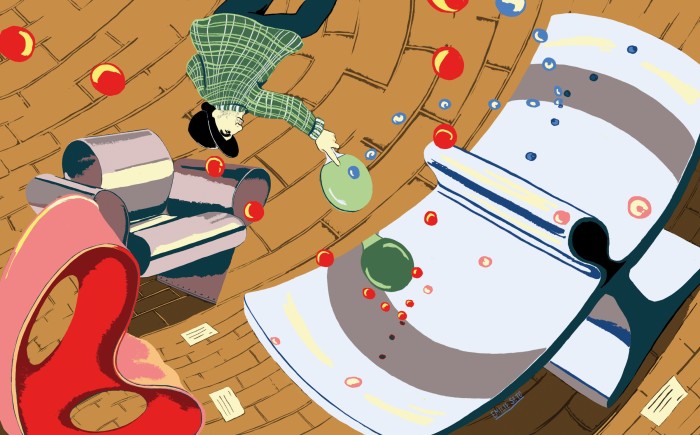How I Spend It: Ron Arad on ping-pong

Roula Khalaf, Editor of the FT, selects her favourite stories in this weekly newsletter.
As a child, I was never good at doing what I was expected to do. For me, it was always about doing things in a different way and yet getting applauded: the whole way I studied, the whole way I went through school, without being methodical.
The first piece of furniture I made was the Rover chair. If, a week before I did the Rover chair, you had told me that I was going to design furniture, I would have asked you, “What are you on?” But I worked for some architects after I graduated from the Architectural Association and I did my thesis about readymades in art, so I had an idea I did nothing about, which was to claim car seats and make a domestic piece of furniture. When I got my first job at an architectural firm it didn’t take me very long to learn I was not made to work for other people. I always say it’s very difficult to work for other people after lunch. So after one lunchtime I didn’t come back and I walked down Haverstock Hill in London and I went to a scrapyard behind what is now The Roundhouse and I did my famous chair. It dragged me into the world of designing furniture.
When I think about designing, I always say, what will happen if I do this? What if I do an upside-down building, what if I design a portable monitor that you can hold in your hands without a keyboard, as I did for LG before the iPad became a reality? What if I make a ping-pong table that has a belly?
Ping-pong, in particular, is a thing for me. It is very popular in my studio in Chalk Farm and I am one of the best players on my ping-pong table. Because it’s different from any other ping-pong table you know. My thought was, what if you make a table that is concave? Yes, it slows the game down a bit; but it makes the rallies longer. And it is something I can absolutely claim as mine, rather than join the queue of other ping-pong table makers. I showed my table at the Royal Academy Summer Exhibition and Sir Anthony Caro said to me, “This is a wonderful sculpture.” And I said, “Thank you Sir Anthony.” And then he whispered in my ear, “You should try and play ping-pong on it.” And that for me was the greatest compliment: that Anthony Caro saw this as a sculpture first before thinking of it as a ping-pong table.
Years after that one, I did a table for a Spanish company. The original only curved one way end-to-end, but they wanted one that curved side-to-side. I called it 10 Layers, because it’s made out of 10 layers of stone. I have a video of the makers playing on it and I was very jealous of them because they got to try it out before me. It was shown in Madrid at the time of the Madrid tennis open championship and I was booked to play a game against Rafael Nadal. It was going to happen at five o’clock in the afternoon after his tennis match in the tournament. But something happened and it was the first match he lost after a long undefeated run. So he packed his things and went; he didn’t turn up for our game. I wrote in my diary that I had a technical victory over Nadal.
I like to win. I showed this ping-pong table at a show in Moscow, and the gallerist wasn’t going to allow anyone to play on it. And I said, “It has to be played on. It’s like shoes. You know, it has to be worn and played,” and that was not a good idea because I didn’t know he was a champion ping-pong player, this gallerist, and I didn’t win a single game against him. You know, in your career, you make mistakes.
Ron Arad’s work is on show at the Royal Academy Summer Exhibition from 6 October; Ron Arad 69 is at Newland’s House, Pound Street, Petworth, West Sussex GU28 0DX, until 7 Jan 2021 (newlandshouse.gallery); and ‘Morgan Undercover’ is at Huntsman, Savile Row from 10-17 Oct and on YouTube Premiere
Comments